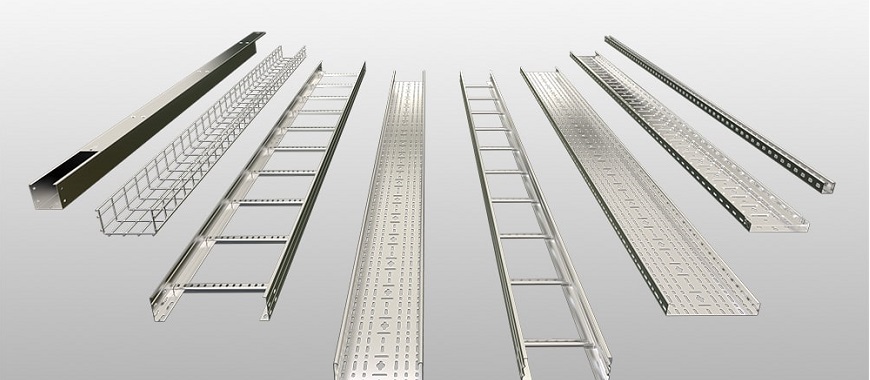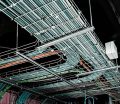
Snap on cable tray systems are innovative solutions for effective cable management. These trays organize cables efficiently while protecting them from damage. The snap-on design simplifies installation, making it quick and hassle-free for users. Unlike traditional methods, no additional tools are required, saving both time and effort. Snap on cable tray systems are compatible with various cable types, ensuring versatility across multiple applications. Their sturdy construction supports different configurations, making them ideal for both small-scale and industrial setups. By reducing clutter and improving accessibility, these trays enhance overall maintenance and safety. Whether used in residential, commercial, or industrial environments, snap on cable trays offer a durable and convenient way to manage electrical cables effectively.
Common Features of Snap On Cable Trays
Snap on cable tray systems are versatile, efficient, and tailored for modern cable management. They combine functionality and durability, catering to diverse applications. The cable tray snap on type is designed for easy installation and reliable performance, making it a preferred choice in various environments. Below, we delve into the essential features that make these trays indispensable.
Size Variations of Snap-On Cable Trays
Standard Sizes for Diverse Needs
Snap on cable tray systems are manufactured in various sizes to suit different cable loads and structural setups. Common widths range from 4 inches to over 24 inches, with lengths and depths adjusted to fit specific environments. The cable tray snap on type ensures compatibility with standard configurations, offering flexibility in design and application.
Choosing the Right Size
Selecting the correct size of snap on cable tray depends on factors like cable volume, load requirements, and space constraints. A wider tray supports heavy bundles, ensuring proper ventilation and avoiding overheating. In contrast, smaller trays are ideal for compact spaces or fewer cables. This adaptability allows for efficient cable organization, promoting safety and ease of maintenance.
Material and Durability
Materials Commonly Used
Snap on cable trays are typically crafted from durable materials like steel, aluminum, and fiberglass. Steel provides robust support for heavy-duty applications, while aluminum offers lightweight strength, making installation easier. Fiberglass, promoted by brands like GangLong Fiberglass, resists corrosion and is ideal for harsh environments.
Resistance to Environmental Factors
The cable tray snap on type is engineered to withstand external conditions like extreme temperatures, moisture, and chemical exposure. Galvanized steel resists rust, ensuring longevity in industrial and outdoor applications. Aluminum and fiberglass options are non-corrosive, making them suitable for marine or chemical facilities. This durability minimizes maintenance costs and ensures a long service life.
The Importance of Choosing Durable Materials
Enhanced Safety and Longevity
Durable snap on cable trays reduce risks of structural failure, enhancing workplace safety. Materials like fiberglass, featured in GangLong Fiberglass products, resist wear and tear effectively. Their longevity makes them a cost-efficient choice for demanding environments. Proper material selection ensures trays maintain their structural integrity, supporting cables without deformation or damage.
By understanding these features, users can make informed decisions about the best snap on cable tray system for their needs.
Types of Snap-On Cable Trays
Snap on cable tray systems are designed to meet diverse cable management needs. From perforated designs to snap track channels, each type offers unique features and applications. Understanding these types ensures that users can select the most suitable snap cable tray for their requirements.
Perforated Snap-On Cable Trays
Features of Perforated Designs
Perforated snap on cable trays feature a series of holes or slots along their structure. These perforations enhance ventilation, allowing heat to dissipate from cables effectively. This design reduces the risk of overheating, which is crucial for maintaining cable performance and longevity. Additionally, the perforations make it easier to secure cables with ties or clamps, improving organization.
One significant advantage of perforated snap on cable trays is their lightweight yet sturdy construction. They are easy to handle and install, reducing labor costs and installation time. Their design also supports better airflow, which is essential in high-temperature environments or where cables are densely packed. For environments exposed to moisture or chemicals, perforated trays made from corrosion-resistant materials provide enhanced durability.
Applications Where They Excel
Perforated snap on cable trays are ideal for environments requiring robust cable management with airflow considerations. These include data centers, industrial plants, and manufacturing facilities. Their ability to support both lightweight and heavy-duty cables makes them versatile across a wide range of industries. At GangLong Fiberglass, our perforated trays combine strength and durability to meet demanding applications.
Snap Track Channels
Versatile Cable Support System
Snap track channels are a specialized type of snap on cable tray designed for maximum flexibility. They feature a streamlined structure that allows cables to be quickly inserted and organized. Their modular design makes them easy to adjust or expand as cable configurations change. The snap cable tray mechanism ensures cables stay securely in place without requiring additional fasteners.
Best Use Cases for Snap Track Channels
Snap track channels excel in applications where frequent cable modifications are needed, such as commercial buildings or telecommunications setups. They are particularly useful for organizing smaller cable bundles in tight spaces. By offering durability and ease of use, these snap cable tray systems are an essential component of efficient cable management.
The Importance of Choosing the Right Type
Matching Design to Application
Selecting the correct type of snap on cable tray ensures safety, efficiency, and cost-effectiveness. For high-density cable installations, perforated trays provide excellent ventilation and organization. Snap track channels are ideal for environments requiring frequent cable adjustments. At GangLong Fiberglass, we prioritize offering options that cater to various needs, combining quality with adaptability.
Understanding the distinctions between these types of snap on cable tray systems allows users to optimize their cable management strategies for long-term success.
Secure Your Cables with Lockable Cable Tray Systems
Installation and Safety Guidelines for Snap On Cable Tray
Installing a snap on cable tray requires attention to detail and adherence to safety standards. Proper grounding and effective installation practices are essential for the long-term safety and functionality of these systems. Below, we explore crucial aspects of installation and safety for snap on cable trays.
Grounding and Earthing Requirements
The Importance of Grounding for Safety
Grounding is essential to prevent electrical hazards in snap on cable tray systems. It ensures that stray electrical currents are safely directed away, protecting both equipment and personnel. Without proper grounding, the risk of shocks and system failures increases significantly.
Step-by-Step Guide to Ensuring Proper Grounding
- Inspect the Tray: Before installation, check the snap on cable tray for any damage or defects that could disrupt grounding.
- Connect Grounding Cables: Attach grounding wires to designated points on the cable tray. Ensure secure connections using appropriate clamps or connectors.
- Verify Continuity: Use a continuity tester to confirm that the entire tray system is grounded.
- Integrate With Building Grounding: Connect the tray system to the main building’s grounding network to maintain a unified safety circuit.
- Regular Maintenance: Periodically inspect and test grounding connections to ensure long-term effectiveness. At GangLong Fiberglass, we emphasize the importance of robust grounding solutions for all our products.
Installation Best Practices
Tips for Secure and Efficient Installation
Installing a snap on cable tray properly ensures optimal performance and minimizes potential issues. Follow these best practices for a secure setup:
- Plan Layouts: Map out the cable pathways before installation to avoid future adjustments.
- Use Appropriate Tools: Employ tools designed specifically for snap on systems to ensure smooth assembly.
- Anchor Securely: Fasten the tray securely to walls or ceilings, using appropriate hardware for the mounting surface.
- Avoid Overloading: Adhere to the tray’s load capacity to prevent sagging or structural damage.
Adhering to Safety Standards
Complying with safety regulations during installation is crucial. Here are some key considerations:
- Follow Local Codes: Check local electrical codes to ensure compliance with legal requirements.
- Maintain Proper Spacing: Keep adequate clearance between the snap on cable tray and other structures to allow for ventilation and maintenance access.
- Inspect Post-Installation: Conduct a thorough inspection after installation to identify any loose connections or alignment issues.
Why Best Practices Matter
Following these guidelines ensures that the snap on cable tray operates efficiently and safely. Proper installation reduces maintenance needs and enhances the longevity of the system. At GangLong Fiberglass, we provide guidance and support to help our clients achieve reliable installations.
Advantages of Proper Installation
Enhanced Safety and Performance
Properly installed snap on cable tray systems reduce risks of electrical faults and structural failures. Grounding minimizes hazards, while secure connections ensure stability under load. These measures collectively improve the system’s reliability.
Ease of Maintenance
Well-planned installations allow for easier access during maintenance. By organizing cables efficiently and avoiding overloading, routine checks become quicker and less disruptive.
Longevity and Cost Efficiency
Correct installation prevents wear and tear on the snap on cable tray, extending its lifespan. This reduces replacement costs and ensures the system delivers long-term value. At GangLong Fiberglass, our focus is on providing durable and efficient solutions that stand the test of time.
With proper grounding, adherence to best practices, and a focus on safety, snap on cable tray systems offer reliable performance in any setting.
Fire Safety Essentials for Cable Tray Penetration Systems
Pricing and Market Overview of Snap On Cable Tray
Snap on cable tray systems are a valuable investment for cable management, with their pricing influenced by several key factors. Understanding the market dynamics in the USA can help buyers make informed decisions while prioritizing quality and reliability.
Factors Affecting Snap-On Cable Tray Prices
Material Considerations
The material used in snap on cable tray systems significantly impacts their price. Steel trays are typically more affordable but can require additional coatings to resist corrosion. Aluminum trays are lightweight and corrosion-resistant, which increases their cost but makes them ideal for demanding environments. Fiberglass trays, such as those offered by GangLong Fiberglass, combine durability with resistance to harsh conditions, reflecting a premium price due to their superior quality.
Size and Design
The size and design of snap on cable tray systems also play a crucial role in pricing. Larger trays with higher load capacities cost more due to the additional materials and engineering required. Perforated and ventilated designs, which enhance airflow and safety, may come at a higher price due to their specialized features. Buyers must evaluate their specific cable load and environmental needs to choose the right size and design within their budget.
Exploring the Cable Tray Market in the USA
Overview of Leading Manufacturers
The snap on cable tray market in the USA is diverse, with numerous manufacturers offering a wide range of products. Companies focus on meeting industry standards for safety and performance, ensuring buyers have access to reliable solutions. At GangLong Fiberglass, we prioritize creating high-quality snap on cable tray systems tailored to meet the unique needs of our clients.
Evaluating Suppliers for Quality
When selecting a supplier, it’s essential to consider their reputation and product quality. Reliable manufacturers offer trays made from premium materials and provide warranties to assure buyers of their durability. Customer support, including installation guidance and after-sales service, is another critical factor when evaluating suppliers in the snap on cable tray market.
Reliability and Cost Efficiency
Investing in a high-quality snap on cable tray system ensures durability and reduced maintenance costs over time. Choosing suppliers who combine competitive pricing with proven reliability helps buyers achieve long-term savings without compromising on safety or performance.
Advantages of Understanding Market Dynamics
Informed Decision-Making
By understanding the factors influencing snap on cable tray prices, buyers can select products that align with their needs and budget. Knowing the material, size, and type required helps avoid overspending on unnecessary features.
Access to Reliable Products
Exploring the snap on cable tray market ensures access to dependable solutions that meet safety and performance standards. At GangLong Fiberglass, we strive to provide top-tier products that deliver consistent value.
Maximizing Long-Term Value
Investing in high-quality snap on cable tray systems may involve higher initial costs but leads to significant savings over time. Durable materials and efficient designs reduce maintenance needs and enhance system longevity, making them a cost-effective choice.
Understanding pricing factors and exploring market options allows buyers to optimize their investments in snap on cable tray systems, ensuring reliable performance and durability in various applications.
Key Steps for Regular Cable Tray Inspection Success
Maximizing Efficiency with Snap On Cable Trays
Snap on cable tray systems have revolutionized cable management, offering a seamless blend of functionality, durability, and convenience. By understanding their advantages and the importance of selecting the right type, users can ensure long-term efficiency and safety. Below, we summarize the key takeaways for making the most of these systems.
Advantages of Snap-On Cable Trays
Efficient and Organized Cable Management
Snap on cable trays streamline cable organization by providing a designated pathway for wires. Their structured layout reduces clutter, which enhances the overall safety and accessibility of electrical systems. With features like snap-fit assembly, these trays simplify installation, saving time and labor. At GangLong Fiberglass, we ensure that our snap on cable tray products are designed for both residential and industrial needs.
Durability and Long-Term Performance
The robust construction of snap on cable trays ensures they can handle various environmental challenges. Whether exposed to high temperatures, moisture, or corrosive substances, these trays maintain their integrity. Durable materials like fiberglass and aluminum enhance longevity, reducing the need for frequent replacements and lowering maintenance costs.
The Importance of Choosing the Right Tray Type
Tailored Solutions for Different Needs
Selecting the appropriate snap on cable tray type is crucial for effective cable management. Perforated trays are ideal for high-density cables needing ventilation, while snap track channels are perfect for compact spaces or modular setups. Each design caters to specific environments, ensuring optimal performance.
Avoiding Overloading and Structural Issues
Choosing the right tray size and load capacity prevents overloading, which could lead to sagging or damage. Evaluating factors like cable volume and installation space ensures the chosen tray meets the requirements while maintaining safety.
Ensuring Proper Installation and Safety
Adherence to Safety Guidelines
Proper installation of snap on cable tray systems is essential for long-term safety. Grounding and securing trays to support structures protect against electrical hazards and structural instability. Compliance with local safety regulations further ensures the system’s reliability.
Regular Maintenance for Longevity
Regular inspections and maintenance are vital for keeping the trays in optimal condition. Checking for wear, corrosion, or misalignment helps prevent minor issues from escalating into major problems. At GangLong Fiberglass, we advocate for proactive maintenance to maximize the value of our products.
Why Snap-On Cable Trays Are a Smart Investment
Snap on cable trays offer unmatched advantages for managing cables in a variety of settings. Their versatility, durability, and user-friendly design make them a cost-effective choice for both small and large-scale projects. By selecting the right type and adhering to proper installation and maintenance practices, users can enjoy long-lasting benefits.
At GangLong Fiberglass, we are committed to delivering high-quality snap on cable tray solutions that combine practicality and reliability. Investing in these systems ensures not only efficient cable management but also peace of mind for years to come.
FAQs about Snap On Cable Tray
There are three primary types of cable trays: ladder, wire mesh, and perforated trays. Ladder cable trays are designed with rungs, allowing excellent ventilation and easy cable entry and exit. They are ideal for heavy-duty cables that generate significant heat. Wire mesh cable trays have a grid-like design, offering flexibility and quick installation, especially in environments with lighter cable loads. Perforated trays feature small holes or slots along their structure, promoting airflow and ensuring cables stay secure. These trays are often used in applications requiring enhanced durability and safety. Each type of snap on cable tray is tailored for specific environments, providing users with versatile options for cable management.
Cables not approved for tray use, such as non-metallic sheath cables without proper certification, cannot be installed in a cable tray. These cables may lack the structural integrity to withstand tray conditions or meet safety standards. Additionally, some tray systems are not compatible with unarmored cables due to the risk of mechanical damage. Always ensure the cables comply with industry standards for tray installations to prevent hazards. When using a snap on cable tray system, it’s essential to follow local codes and regulations to maintain safety and functionality.
Yes, cables can be spliced in a cable tray, but only if local codes and regulations permit it. The splices must be secured properly and insulated to ensure safety and functionality. It is essential to use approved splice kits and connectors designed for the specific cable type. When working with a snap on cable tray system, ensure the splicing process does not obstruct the tray’s airflow or compromise its structural integrity. Regular inspections should be conducted to confirm that the splices remain intact and pose no safety risks.
No, a person should not walk on an installed cable tray system unless it is explicitly designed to support such weight. Cable trays are engineered to support cables, not the weight of people, and walking on them can cause structural damage or pose safety risks. If access is required above a snap on cable tray system, proper walkways or platforms should be used. Following safety guidelines ensures the longevity of the tray and the safety of individuals.

As the editor of GangLong Fiberglass, I have years of experience and in-depth research, focusing on cable tray products, fiberglass solutions, and grille systems. I incorporate years of industry insights and practical experience into every content, committed to promoting the progress of the industry. At GangLong Fiberglass, my commitment is reflected in every product, from innovative cable trays to durable fiberglass solutions and sturdy grille systems. As an authoritative voice in the industry, my goal is to provide valuable information to professionals and businesses and promote forward-looking solutions.


